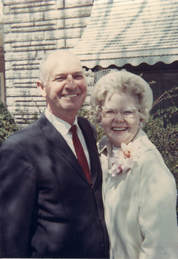 Riding long distances with three children in the backseat of an un-air conditioned 1956 Plymouth was sometimes a trying situation and, to keep us entertained one time, my dad pointed to a fly buzzing around in the car with us. He asked how fast the fly was flying. I cannot accurately judge the combined mental strength of the three boys in the backseat, but it was a question that made us ponder for several minutes. If the fly started with us, and then got out of the car when we stopped, then the fly must have covered the same distance during the same amount of time as we had, so it must have been flying as fast as the car was going, which was about fifty miles an hour, tops (it was a flathead six, for those of you who must know such things). However, even to us, it didn’t seem like the fly was flying fifty miles an hour. The fly, on average, seemed a lot slower. The explanation was offered that the fly didn’t have to fight the air resistance, so fifty miles an hour seemed reasonable. The problem was, as my mother pointed out, the fly seemed to fly just as fast going forward as it did going backward, leading to the obvious conclusion was that if it was flying fifty miles an hour going forward, then it was also flying fifty miles an hour going backwards. Also, she pointed out, when the fly lands on the back of the seat, it is not flying at all, and yet was making progress down the road. Those of us in the backseat weren’t the sharpest tools in the shed, but it seemed we had made even less progress towards a good answer. My dad complicated the situation. If we are inside the car with the fly and could measure its speed using a yardstick and a stopwatch, it was probably flying the usual speed of a fly, which is about 4 to 5 miles an hour (for those of you who also needed to know that it was a flathead six). On the other hand, if one of us was standing alongside the highway and measured the speed of the fly as the car zoomed by, then the fly would, indeed, be measured at the same speed as the car, plus or minus a little if it was flying forward or backward. I think my Dad was just looking to befuddle us, which was not hard to do, but that fly has persisted in my mind to this day. To be completely honest, I still am trying to find a way to succinctly express the absolute truth about the situation. Using the words “frame of reference” helps. I talked about “frames” in a previous blog – how, even presented with the same scenery outside a car window, for instance, we each see different things dictated by the “frame” through which we see things. That frame is defined by our mental attitude at the time (whether looking as a videographer, a photographer, a tourist, a geologist, a historian, etc.) so that we register a different experience from the person beside us, even though we are looking at the same thing. One class of “frames” that we commonly use is a “frame of reference”. Remember that your algebra teacher talked about a “frame of reference” because when you draw an x-y graph (two axes crossing at right angles to each other) and you locate a point on that graph, you get a measurement for x relative to the crossing of the two axes (called the origin), measured along the x axis, and a measurement for y relative to the place where the two axes cross, measured along the y axis, and the resulting x and y measurements form the (x, y) pair that names that point. The teacher then pointed out, usually in a cavalier way, that if you moved the point of origin, then the measurements changed and the (x, y) pair had different numbers. You had changed the “reference point” of the graph. If the teacher would have quit right there, you would have been alright: life seemed simple and straightforward. But your algebra teacher proceeded to talk about straight lines, curved lines, greater than and less than, and circles and parabolas and asymptotes and sine waves and that’s when you decided to become a writer. See, to the writer, the fun in the backseat was not answering the question of the speed of the fly, but that the middle child would always make up an answer opposite the answer of the oldest child, who was always a foot smarter than the other two of us, while the youngest child looked at his mother with pitiful eyes, hoping she’d give him the answer. It all resulted in a barrage of “yes, it is” and “no, it’s not” and degenerated into a race of each of the three boys trying to make it to “stupid” line before the others. Conflict! It’s what a writer lives for. Every beginning “how to write” book will tell you that you have to have “conflict” to have a good story. A good story is always told against a backdrop of drama and using conflicting frames of reference is a standard way to get characters to battle each other. It works even better if each character has considerable investment in their own respective positions. After a few minutes of the ensuring war in the backseat, I’m pretty sure that my Dad regretted asking the question. A minute later, he swatted the fly.
2 Comments
Donna Bogan
4/9/2018 10:42:30 am
Donald, I am laughing so hard! I don't remember trips with my 3 siblings, but on trips with Sandra and David, l was always in the middle--to keep them apart!
Reply
4/9/2018 08:16:04 pm
We just counted cows or red cars, then lose the count when a graveyard is on the side of the road you are counting on. I can see how you got your love of physics and math.
Reply
Leave a Reply. |
AuthorDon Willerton has been a reader all his life and yearns to write words like the authors he has read. He's working hard at it and invites others to share their experiences. |

 RSS Feed
RSS Feed